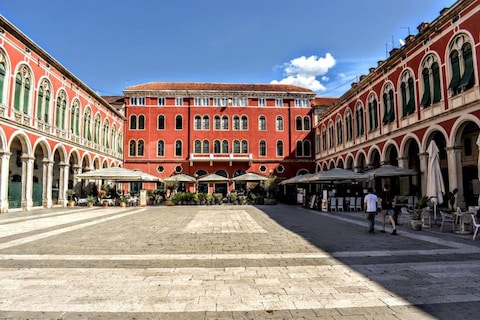Split
Split, nestled on Croatias Dalmatian Coast, is a city that beautifully marries ancient history with modern charm. With approximately 30C in summer, its perfect for exploring the UNESCO-listed Diocletians Palace or basking on the sun-kissed beaches. In the cooler months, enjoy the peaceful atmosphere and delve into the local culture. Split is a year-round destination, each season offering a unique experience.
Things To See & Do



Starigrad Fortress
Historic Fortification with City Views
1-2 hours
Suggested Time

Split Riva
Iconic Waterfront Promenade
1-2 hours
Suggested Time

Saint Domnius Cathedral
Iconic Cathedral in Split
1-2 hours
Suggested Time

Republic Square
Central Square with Historic Charm
1-2 hours
Suggested Time

Plitvice Lakes National Park
Natural Wonderland Near Split
Full day (approx...
Suggested Time

Peoples Squares
Historic Gathering Places
1-2 hours
Suggested Time

Old Town Hall
Historic Government Building in Split
1-2 hours
Suggested Time


Kupaliste Bene
Scenic Beach and Park in Split
Half day (approx...
Suggested Time

Krka National Park
Waterfalls and Natural Beauty Near Split
Full day (approx...
Suggested Time

Klis Fortress
Medieval Fortress with Historical Significance
1-2 hours
Suggested Time


Jupiters Temple
Ancient Roman Temple in Split
30 minutes to 1 ...
Suggested Time

Diocletians Palace
A Roman Emperors Legacy
2-3 hours
Suggested Time

Forest Park Marjan
Nature Oasis Above Split
2-3 hours
Suggested Time

Diocletians Cellars
Ancient Underground Complex
30 minutes to 1 ...
Suggested Time

Castle Vitturi
Hidden Gem of Medieval Architecture
1-2 hours
Suggested Time
Best Time To Visit Split
Summer/Autumn Destination
JUL-AUG
Peak Season
MAY-OCT
Moderate Season
NOV-APR
Off-season
- What To Expect:Warm weather, vibrant nightlife, and a surge of tourists.
- Things You'll Love:Exploring historic sites, enjoying beach activities.
FESTIVALS AND EVENTS
Book Your Trip to Split
Stay in Split
Recommended Options
3 STAR HOTELS
Recommended For You
Average Price
₹11,258

Hotel batuda
Split City Center
₹7,046
Onwards

Hotel Peristil
Grad (City Centre)
₹15,471
Onwards
4 STAR HOTELS
Recommended For You
Average Price
₹21,909

AC Hotel by Marriott Split
Split City Center
₹8,762
Onwards

Cora Hotel
Split
₹10,555
Onwards

Lanterna Rooms
Split City Center
₹46,412
Onwards
5 STAR HOTELS
Recommended For You
Average Price
₹11,182

Cornaro Hotel
Grad (City Centre)
₹13,344
Onwards

Hotel Ambasador
Varoš
₹10,044
Onwards

Hotel Park
Bacvice
₹10,158
Onwards
Discover by Interest
More about Split!
You will love exploring historic sites, enjoying beach activities. Take your beach love to Split.
Here are a few quick facts to make your travel safe and easy to Split. Split is a International destination. The best time to visit Split is July and August. Since this is the peak season expect a little crowd during this time. May, June, July, August, September and October period experiences moderate weather. So, you can easily avoid facing a large gathering.
In peak season the weather is warm weather, vibrant nightlife, and a surge of tourists, whereas in off-season the weather is cooler weather, fewer tourists, and discounted rates. Weather in moderate season is mild temperatures, fewer crowds, and lower prices. During Split Summer Festival, St. Domnius Day,… a large number of tourists flock together. The festivals are celebrated in the month of July/August, May,... consecutively. So, if you are fond of bustling streets and localities, choose this time of the year to travel.
If your travel seems incomplete without getting into some fun activities then you will love to get indulged in exploring historic sites, enjoying beach activities. In moderate season you will love to get indulged in sightseeing, local festivals, and traditional cuisine.
Country | Croatia |
Sustipan, Starigrad Fortress, Castle Vitturi, Diocletians Palace, Saint Domnius Cathedral | |
Best Time to Visit Split | July to August |
Restaurants in Split | sug Restaurant, Vege Vegan Street Food Restaurant, Barakokula Plant Based, Fig Split, Feel Green Restaurant |
Split is famous for | Beach, Foodie Hotspots, Museums |
FAQs - Frequently Asked Questions about Split
What are the activities you can explore during the peak season and moderate season in Split?
In the peak season months July and August you will experience warm weather, vibrant nightlife, and a surge of tourists wherein around moderate season i.e. May, June, July, August, September and October you will enjoy mild temperatures, fewer crowds, and lower prices. Whatever that suits your calendar, Split awaits you for a good time.
What are the popular things to explore in Split?
The most loved tourist places to explore in Split are Vestibul, Sustipan and Starigrad Fortress. You will have an amazing time exploring these places and come back home with a bag full of memories.
What is the best time to visit Split?
Ideally the best time to visit any place is considered when the weather conditions are delightful. For Split, you can choose to go in July and August which is the peak season and May, June, July, August, September and October which is the moderate season. Both will serve you well to unwind from your tedious routine.
In what country is Split?
Split is located in the beautiful country of Croatia, nestled on the eastern shore of the Adriatic Sea.
What is Split famous for?
Split is famous for its beaches and the fortress-like complex at its centre, Diocletians Palace, erected by the Roman emperor in the 4th century. Its also known for its vibrant nightlife and delicious local cuisine.
Why is Split, Croatia called Split?
The name split' comes from the spiny broom (Calicotome spinosa; brnistra or žuka in modern Croatian), a common shrub in the area, after which the Greek colony of Aspálathos or Spálathos was named.
Is Split an expensive city?
As for expenses, Split is generally considered more affordable than many European cities, but it can be a bit pricier than other parts of Croatia, particularly during the peak tourist season. However, with a bit of planning, a trip to Split can fit a variety of budgets.










